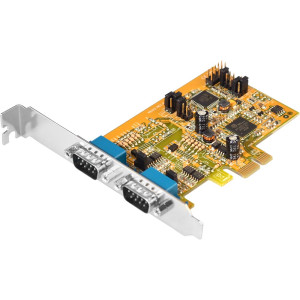Your shopping cart is empty!
MENU

They don’t make them like they used to. In technology, this truth forces us to use old devices alongside new components. Enabling them to communicate in harmony is one of the perpetual challenges of the job. If you have legacy devices that can’t be replaced, keep them in form by utilizing PCI or PCI Express (PCIe) RS-232, RS-422, and RS-485 serial boards. Their suite of options – number of ports, surge protection, and low-profile height - allows you to add serial ports to any server or desktop in short order. These serial boards are an excellent way to connect old printers, plotters, instruments, and other serial devices to the latest computers.
Few new computers come with a serial port. Without the DB9-style connector, there’s no easy way to hook up older hardware that uses the RS-232/422/485 standards. And even when the port is present, it’s only possible to connect a single serial instrument. Connecting older serial equipment to a new PC is possible by installing a serial interface card. These are available in full-height and low-profile formats for both RS-232 and RS-422/485.
A multi-port serial interface card addresses many common issues with serial connections. Easily installed in a spare interface slot in the PC, these cards can accept connections from up to 16 separate serial devices. This way, data acquisition or automation hardware is managed from a single location. Westward Sales carries serial interface cards for both the PCI Express slots found in new PCs and the older PCI bus. These come with utilities and drivers for both Windows and Linux.
The serial interface card must be matched to the bus in the PC. Older computers used PCI, which came in two versions. Version 1 is distinguished by a single notch in the interface card. It used 5V signaling. The later Version 2 used 3.3V. A Universal PCI card works with both versions and is identified by two notches.
PCI Express cards are not interchangeable with PCI. These use multi-lane technology to achieve much higher speeds than PCI can deliver. Lanes are designated as “x1, “x4,” “x8,” “x16,” and “x32.”
PCI interface cards are available in both low-profile and standard (full-height) formats. In a low-profile card, the bracket securing the card in the case measures 79.2 mm, while that on a full-height card is 120 mm. Always purchase the right height card for the destination PC.
Legacy devices are as diverse as their modern counterparts, so you won’t find a universal solution. Instead, we can offer a precise card for any needed function. Consider the MSC-202AL1. This low-profile card adds two RS-232 serial expansion ports. Designed for PCIe, it is backward-compatible with PCI applications and supports data rates up to 250MB/s. It offers power over pin 9 and features drivers compatible with both Windows and Linux.
The MSC-202ALP1 expands 2 serial ports and 1 parallel port. It can provide 5V or 12V power over the ports and is scalable and backwards compatible. The low-profile form factor allows it to fit more freely in a wider range of racks and servers, making it an easy choice for many applications.
For more restrictive stations, the low-profile MSC-104CL is an excellent option. It supports universal serial applications, including 2-wire and 4-wire RS-422/485 connections. Dual-functioning as both client and server, it seamlessly integrates into your system. And it offers an option of 15 kV surge and 2,500 Vrms isolation for added protection.
By committing to PCI connections, serial boards are easily integrated into any standard setup. The MSC-102A 2-Port RS-232 allows you to add two serial connections for the cost of one PCI slot. It is preinstalled with modern Windows and Linux drivers, so you can quickly add them with little labor. The 32-bit architecture supports data rates to 133 MB/s, ensuring the card will never create a bottleneck.
PCIe RS-232, RS-422, and RS-485 PCI and PCIe serial boards will keep your legacy serial devices in service. The best way to optimize your network with minimal downtime is through careful planning. Our experts can help you achieve that by informing you of the latest and most reliable technology options available. Talk with us today! We’ll make sure you have all of the resources necessary to keep your serial-based systems in top shape.